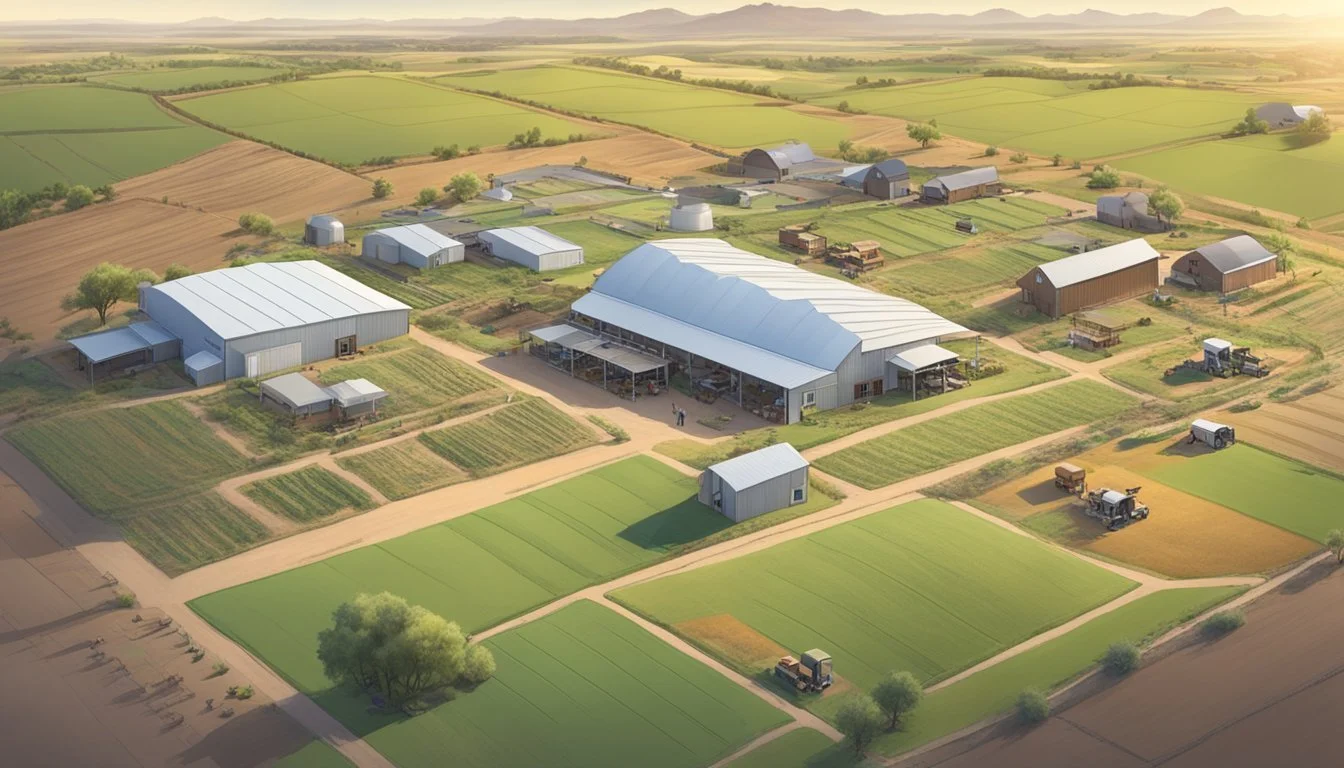Right to Farm Law in Arizona
Understanding Agricultural Protections
The Right to Farm Law in Arizona serves as a significant legal framework designed to protect the interests of farmers and maintain the viability of agricultural operations within the state. Initially proposed in 1981, the law establishes a safeguard for agricultural lands, allowing farmers to continue their work without the threat of nuisance litigation potentially leading to the premature loss of farmland. As agricultural operations have expanded by 144% in Arizona, despite a reduction in the number of acres farmed, this legislation has become a cornerstone in ensuring that farming—the backbone of rural Arizona—remains sustainable and shielded from the encroachment of non-agricultural development pressures.
Over time, the needs of Arizona’s agricultural landscape have evolved, prompting updates to the Right to Farm Law to address new challenges. These updates are pivotal in fortifying the protections it offers, particularly as the state witnesses sizable growth in rural areas, often leading to new residents who may lack a connection to the agricultural heritage and practices of their new communities. The law's clear definition of acceptable agricultural practices and the circumstances under which farming is protected demonstrate Arizona’s commitment to preserving its rural character and agricultural productivity.
The Right to Farm Law not only acts in defense of existing farming operations but also underscores Arizona's acknowledgment of the importance of agriculture to the state's economy and cultural heritage. By mitigating the tension between farming activities and neighboring land uses, the law ensures the endurance of agricultural pursuits amidst a changing landscape, positioning the state's farming community to continue thriving into the future.
Historical Background
The introduction of Right-to-Farm (RTF) laws in Arizona dates back to 1981 when state legislators identified a growing concern for farm and ranch operations. The aim was to safeguard agricultural interests from non-agricultural urban encroachment and related nuisance lawsuits.
Legislation Emphasis:
Protection: RTF laws provided legal armor against nuisance litigation that could lead to premature removal of land from agricultural use.
Support for Farmers and Ranchers: The legislation aimed to ensure the longevity of farming and ranching practices within the state.
Legislative Impacts by the Numbers:
Growth: Post-legislation, Arizona saw a 144% increase in the number of farm operations.
Land Usage: Concurrently, the total agricultural acreage fell by 31%.
The trend showcased a shift in Arizona's rural landscape, with smaller farms becoming more prevalent even as total acreage declined. In practice, Arizona's Right-to-Farm law outlines specific definitions and exemptions pertinent to agricultural law.
Given the wide range of operations in Arizona's rural areas—from expansive cattle ranches to intensive crop farms—these definitions play a key role in the application and enforcement of the RTF laws. Each term provides a framework that guides legal outcomes and fortifies the rights of farm and ranch owners against urban expansion and the potential hostilities that come with changes in land use.
Key Provisions of Arizona's Right to Farm Law
Arizona's Right to Farm laws offer a specific framework to support agricultural activities while balancing public health considerations. This section delineates the critical aspects of the legislation, ensuring clarity on its impact for farmers and the community.
Nuisance Protection
Under Arizona's Right to Farm law, farmers and ranchers receive protection against nuisance lawsuits from neighbors who may have moved to the area after the establishment of the agricultural operations. To receive protection, the operation must be:
Pre-existing: Established before surrounding non-agricultural land uses.
On farmland: Conducted on land designated for commercial agricultural production.
Public Health and Safety Considerations
The law does not provide blanket protection and is designed to consider public health and safety. For a nuisance claim to succeed against an agricultural operation, the claimant must prove substantial interference by demonstrating:
A credible threat to public health and safety resulting from the farm's practices.
Evidence that the farm's operations exceed normal agricultural standards.
Qualifying Agricultural Operations
The law protects a range of activities deemed as agricultural operations. An agricultural operation includes all the following conducted by owners, lessees, or their agents:
Production of crops, livestock, poultry, or related products.
Activities for the purpose of agritourism.
Additionally, the statute protects independent contractors and suppliers involved in these activities, ensuring comprehensive coverage for the agriculture sector.
Comparison with Other States
Arizona's Right-to-Farm laws are part of a national framework aimed at protecting agricultural operations from nuisance lawsuits. Each state has developed its own approach to Right-to-Farm legislation, with variations that reflect local agricultural priorities and legal interpretations. This section examines the Right-to-Farm Acts of North Carolina and California in relation to Arizona's, highlighting key differences and the role of entities such as the National Agricultural Law Center in providing research and legal insight.
North Carolina's Right to Farm Act
North Carolina has made a distinct effort to strengthen its Right-to-Farm laws in response to an increase in nuisance lawsuits. Unlike Arizona, where the number of farm operations has increased despite a reduction in farmed acreage, North Carolina's amendments indicate a pressing need to provide heightened legal protections for farms arguably beyond what is granted in Arizona. Key points comparing Arizona's and North Carolina's Right-to-Farm Acts include:
Nuisance Lawsuit Protection: North Carolina's law is designed to offer robust protection against what it deems frivolous nuisance lawsuits, which might be more comprehensive than Arizona's measures.
Financial Penalties: There is a focus in North Carolina on shielding farms from potentially enormous financial penalties as a result of nuisance claims, reflecting a possible difference in legal remedies available in Arizona.
California's Agricultural Laws
California, as one of the leading agricultural states in the United States, has a compelling framework of agricultural laws that encompass a broad array of activities and protections, including Right-to-Farm provisions. Points of comparison between California and Arizona's legislation involve:
Agricultural Precedence: California has established extensive laws that support a wide range of agricultural activities, potentially offering a more intricate array of protections to farmers compared to Arizona.
Diversity of Operations Supported: With its vast variety of climate zones and crop types, California's laws may cater to a more diverse array of agricultural operations than those seen in Arizona.
The National Agricultural Law Center provides a comprehensive collection of resources that can further elucidate the subtle and more pronounced differences between each state's Right-to-Farm laws, offering a depth of analysis for those interested in the specifics of state-level agricultural legislation.
Legal Challenges and Nuisance Lawsuits
In Arizona, Right to Farm Laws have faced several legal challenges, primarily through nuisance lawsuits. These lawsuits often center on disputes regarding odors, noise, and other disturbances typically associated with agricultural operations.
Case Studies
Spur Industries v. Del E. Webb Development Co.: A landmark Arizona case where a cattle feedlot, Spur Industries, was sued for the nuisance caused by odors affecting a nearby residential development. Despite the agricultural operation being in place before the development, the court ordered Spur to relocate, emphasizing the need for balance between agriculture and urban expansion.
Substantial Interference: Arizona's Right to Farm laws require that a nuisance case against an agricultural operation must prove "substantial interference" by showing a threat to public health and safety from the farm's practices.
Punitive Damages and Bad Faith
Statutory Limitations: Arizona law imposes restrictions on nuisance lawsuits against farming operations. For instance, Senate Bill 1224 limits the time frame to file such lawsuits to within one year of the commencement of the operation.
Bad Faith Litigation: Plaintiffs in nuisance lawsuits must not act in bad faith. Any litigant found to be suing an agricultural operation in bad faith or for punitive damages without a substantiated claim of "substantial interference" may face legal repercussions.
Implications for Farm Management Practices
The Right to Farm Law in Arizona has direct consequences for how farming operations carry out their daily activities. Under this law, farms are encouraged to implement best management practices that align with agronomic standards while also taking into account legal protection from nuisance lawsuits.
Best Management Practices for Livestock
Farms with livestock operations are advised to develop comprehensive manure management plans that not only contribute to soil health but also comply with environmental regulations. These plans often include:
Proper storage: Ensuring manure is stored in a way that minimizes odors and prevents runoff.
Manure application: Timing and methods of manure application are critical to optimize nutrient uptake by crops and reduce the risk of nutrient leaching or runoff.
Crop Production and Soil Health
For crop production, Right to Farm Law underscores the importance of maintaining soil health through sustainable practices. These practices encompass:
Crop rotation: Changing the types of crops grown in succession to improve soil fertility and disrupt pest cycles.
Cover crops: Utilizing cover crops to reduce erosion, increase organic matter, and enhance soil structure.
By adhering to these management practices, farming operations can improve their sustainability and resilience, while being backed by the Right to Farm Law in the event of nuisance claims.
Residential Conflicts and Urban Development
The friction between the expansion of residential areas and the operations of existing farms highlights critical issues within Arizona's Right to Farm Law, with impacts on both neighbors and urban development.
Rural-Urban Interface Issues
In Arizona, the interface between rural farmland and expanding urban areas has resulted in conflict. Neighbors, often new to rural living, come into contact with the daily realities of agricultural work, leading to disputes. These disputes typically center on noise, odors, and other byproducts of farming that can be seen as nuisances to residential lifestyles. As urban development pushes into rural areas, the pressure on farmers to adapt or contest nuisance complaints has increased noticeably.
Sun City and Residential Growth
Sun City, an example of a rapidly growing area, encapsulates the tension between residential growth and farming operations. The influx of new homes into traditionally agricultural lands necessitates a clear and effective application of the Right to Farm Law. The law's existence aims to protect farmers from litigation that could arise due to the natural byproducts of their work. However, this protection must be balanced against the expectations and quality of life of the new residents, leading to a complex matrix of interests that must be carefully navigated.
Legal Resources and Assistance
In the context of Arizona's Right to Farm laws, access to legal resources and assistance is crucial for farmers seeking to understand their rights and obligations. The state provides various avenues for legal support tailored to agricultural needs, encompassing aspects like statutory interpretation and the potential recovery of attorneys' fees in specific instances.
Legal Representation for Farmers
Farmers in Arizona can seek legal representation from attorneys who specialize in agricultural law. These lawyers are skilled in the nuances of Right to Farm laws and can help producers navigate disputes effectively. If a farmer is involved in litigation deemed not in good faith or for improper purposes, the amended statute allows courts to award reasonable costs and attorneys' fees to the prevailing party. This seeks to deter frivolous lawsuits and provides a safety net for farmers wrongly accused of nuisance.
Statutory Language Interpretation
Understanding the statutory language of the Right to Farm laws is vital for farmers to ensure compliance and to shield themselves from unwarranted litigation. The National Agricultural Law Center offers resources for interpreting state statutes, including those relevant to Arizona. Farmers can also consult the State Bar of Arizona for materials and guidance on navigating the nuanced language within these laws. Through these resources, producers gain clarity on definitions, obligations, and protections under the law.
Regulatory Framework and Compliance
In Arizona, the Right to Farm Law operates within a multifaceted legal environment that includes federal and state-level directives. Producers must adhere to this framework to maintain compliance and enjoy the law's protections.
Federal and Local Agricultural Laws
Federal laws establish the broad groundwork of agricultural practices, with key statutes such as the Food Safety Modernization Act (FSMA) setting nationwide standards. Locally, the Arizona Right to Farm Law, known colloquially as the "Agriculture Protection Act" since 1995, complements federal regulations. It is critical for operations to align with both spheres of legislation for legal protection and streamlined compliance.
Federal Laws: Mandatory for compliance on all agricultural lands.
Food Safety Modernization Act (FSMA)
Other relevant federal statutes as applicable.
Local Laws:
Arizona Revised Statutes §§3-111 to 3-112.
Amendments up to and including those from 2021 sessions.
Safety Regulations and Compliance
Safety regulations are paramount and must be rigorously followed. The FSMA mandates thorough training, inspections, and information collection to ensure Arizona's agricultural products are safe for consumers. State laws further dictate safety on farms, requiring compliance for the continuation of farm operations under the Right to Farm protections.
Compliance Checklist:
Conduct FSMA-mandated produce safety rule trainings.
Undergo regular safety inspections.
Maintain up-to-date farm inventory and documentation.
By operating within this regulatory framework and adhering to the mandated safety regulations, agricultural entities can ensure they are compliant with both state and federal laws, protecting the viability and safety of their farming activities.
Educational and Research Contributions
The National Agricultural Law Center and the analysis of legal developments are instrumental in understanding the impact of Arizona's Right to Farm Law. They provide resources that are valuable for researchers, policymakers, and the agricultural community.
Role of the National Agricultural Law Center
The National Agricultural Law Center (NALC) stands as a pivotal resource for legal issues in agriculture. Senior Staff Attorney Rusty Rumley and his team contribute significantly with their expertise. The NALC provides comprehensive research materials and legal publications that inform stakeholders about current and changing laws affecting agriculture. Their work includes compiling information on Right to Farm statutes nationally, including those specific to Arizona. This has allowed the NALC to act as an educator, facilitating better understanding and compliance with agricultural laws.
Charting Legal Developments
The NALC continuously charts legal developments related to agricultural laws. Researchers meticulously update charts to reflect new legislation and notable changes at state and federal levels. One such chart lists Right to Farm statutes, which includes Arizona's updated law as of 2021. The utility of these charts lies in their ability to present complex legal information in an accessible format. Such tools are critical for legal professionals, farmers, and local governments to stay informed about their rights and responsibilities under the law, ensuring that educational and research endeavors are aligned with the most current legal landscape.
Media Coverage and Public Perception
Media outlets play a crucial role in shaping public perception of Arizona's Right to Farm laws. This coverage impacts understanding of farming disputes and influences opinion on agriculture's relationship with public health and safety.
News Reports on Farming Disputes
Media reporting on disputes related to Arizona's farming operations often highlights the tension between agricultural practices and nearby residents. Reports emphasize cases where residents express concern over nuisances and potential impacts on public health. They sometimes cite specific instances where the updated Right to Farm laws protect farmers from nuisance lawsuits, which residents might perceive as a hindrance to addressing their complaints. The media's role is significant in bringing these issues to the forefront, providing a platform for various stakeholders to voice their opinions.
Influencing Public Opinion
The way news outlets present information on Right to Farm laws can sway public opinion. Effective reporting includes factual representation of the laws' intentions to protect farmers while simultaneously examining their implications for urban development and public health. By doing so, the media can foster a more informed public, critical for robust public discourse. Balanced coverage includes:
Impacts on Public Health: Assessments of how farming activities might affect local populations.
Agricultural Practices: Information on farming methods and their relevance to public safety.
Legislative Changes: Reporting on updates to the law, presenting perspectives from policymakers, farmers, and residents.
Public Concerns: Coverage of community meetings or interviews with residents affected by agricultural operations.
News stories focusing on these aspects contribute to a neutral and comprehensive understanding of the Right to Farm laws.
Conservation and Sustainability Efforts
In Arizona, the focus on conservation and sustainability within farm legislation is designed to ensure that agricultural operations can function efficiently while preserving the land for future generations. Initiatives by groups such as the American Farmland Trust help promote these goals, assisting landowners in maintaining sustainable practices.
American Farmland Trust Initiatives
The American Farmland Trust (AFT) plays a pivotal role in conservation efforts across every state. In Arizona, AFT undertakes measures to safeguard the farmlands through:
Educational Programs: Providing resources and training to landowners on how to conserve their soil, water, and other natural resources.
Policy Advocacy: Advocating for laws that encourage or mandate conservation practices within farm operations.
Promoting Sustainable Agriculture Operations
To promote sustainable agriculture operations, Arizona's legislation, including the right-to-farm laws, complements federal programs like those announced in the Inflation Reduction Act. Significant strides include:
Conservation Funding: With a $20 billion increase for conservation programs, Arizona's agriculture operations benefit from federal funds that encourage sustainable farm management practices.
Technical Support: The state's agriculture departments, often in consultation with the Department of Environmental Quality, offer advice and support to farm owners, ensuring that they adhere to both state and federal conservation guidelines.











